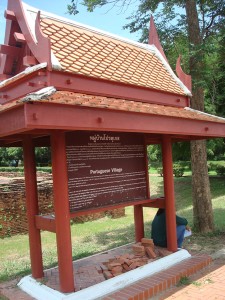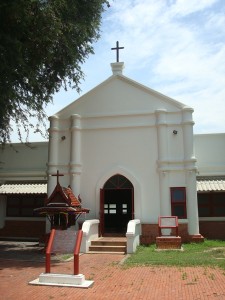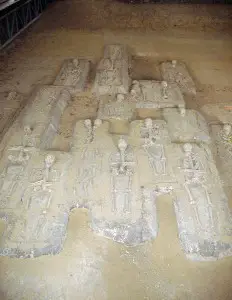 Its vicinity to Bangkok and its hundreds of ancient ruins make Ayutthaya one of the most visited tourist attractions in Central Thailand. Unfortunately, Ayutthaya is a very touristy place, with numerous tailor-made programs for the busy traveller who has only one day to spend in this quiet city. But, there’s more to Ayutthaya than the downtown temple complexes, the Historical Study Center, and the chained-elephant show.
Its vicinity to Bangkok and its hundreds of ancient ruins make Ayutthaya one of the most visited tourist attractions in Central Thailand. Unfortunately, Ayutthaya is a very touristy place, with numerous tailor-made programs for the busy traveller who has only one day to spend in this quiet city. But, there’s more to Ayutthaya than the downtown temple complexes, the Historical Study Center, and the chained-elephant show.
For those who like to go off the beaten track and experience some of the more secluded and bizarre sites in Ayutthaya, I recommend the Portuguese Village. Also called the Portuguese Settlement or Campos Portugues, it is located in the southern part of Ayutthaya, in Tambon Samphao Lom (the “Capsized Junk” sub-district). Actually, if you visit the Japanese Village (one of the more popular attractions), the Portuguese Village can be seen right on the opposite side, on the west bank of the Chao Phraya River.
The settlement covers an area of over half a square kilometre and, during the time when the City of Ayutthaya was the capital of the Siamese Kingdom, it boasted a population of about 3.000 people. It was the biggest western community of that time, mostly made up of Portuguese militia, shipbuilders and merchants. This is not surprising as, during the reign of King Rama Thibodi II in the 15th century, Portugal was the first western nation to come in contact and develop friendly relations with Ayutthaya.
Their village was so diverse and striving in commerce that not one, but three Roman Catholic churches were built on its grounds: the Church of San Petro (for the Dominican sect, referred to by the Siamese as Baan Jacobin), the Church of San Paolo (for the Jesuit sect, Baan Jesuit) and a church for the Franciscan sect. The Portuguese settlement was completely destroyed, alongside the rest of the city, by the invading Burmese army in 1767. Only the ruins of the Church of San Petro are still standing (together with a restored graveyard), while the exact location of the other two churches is still a matter of archaeological research.
After the Portuguese captured Malacca (today a state in Malaysia) in 1511, the Portuguese sent an envoy to Ayutthaya to explain the new situation, as Malacca was at that time a vassal to Siam. The Siamese raised no objections and, after a third visit by the Portuguese representatives stationed in the region, a treaty was signed. In return for firearms and ammunition, the Portuguese were guaranteed religious freedom and were allowed to establish a settlement and engage in trade in the Kingdom.
Just like their Japanese neighbours across the river – many of which attended services in their Catholic churches –, Portuguese soldiers joined forces with the locals to curb the Burmese expansionist policy. They provided not only military personnel, but also weapons and training, which was very good for business. Too bad the Portuguese sold arms to the Burmese too! Still, for their services, the King granted them several commercial and residential privileges, and thus a piece of land in the southern part of Ayutthaya became the official residence for the Portuguese diaspora. As their numbers increased, several Dominican, Jesuit and Franciscan missionaries arrived in Ayutthaya and helped build up the community.
About one century after the arrival of the Portuguese in Siam, the Dutch started to make their presence felt in the region and soon, the balance of influence in trade and at the Siamese Court changed. Things worsened when, in 1624, a Spanish captain attacked a passing Dutch yacht in Siamese territorial waters. As a result, hundreds of Spaniards were killed or thrown into prison. The Siamese considered the Portuguese to be in league with the Spanish soldiers, and they were subjected to a similar treatment for the next three years. With time, relations returned to a peaceful coexistence and the Portuguese were once again thriving in Ayutthaya. By the late 17th century, historical accounts put the number of households in the Portuguese Village at eight hundred.
The settlers of the Campos Portugues took up arms in defending their homes twice: once in 1960, when they managed to force the Burmese army to retreat, and once in 1767, when they were outnumbered and their village was burnt down, together with the rest of Ayutthaya, by the same invading Burmese.
Today, all that’s left of the original Portuguese Settlement are ruins of some houses and of the Church of San Petro. The original Dominican church was of a medium size, standing at 50 meters in length and 40 meters in width. It had a foundation with a depth of 1.6 meters. The entry to the church faced east, toward the Chao Phraya River and the compound included both a ceremonial hall and a residence for the priest. In front of the church, on the riverbank, there was a cemetery in which more than 200 burials have been found.
The Fine Arts Department, with funding from the Calouste Gulbenkian Foundation from Lisbon, excavated the ruins of the church for over a decade between 1984 and 1995. With the unearthing of the graveyard, the Portuguese Settlement became an archaeological site and was open to the public in the presence of the late Princess Galyani Vathana in 1995.
 The graveyard was subsequently covered with a roofed structure and the unearthed skeletons are left opened. At the fall of Ayutthaya in 1767, the surviving Portuguese were taken to Burma as hostages while others escaped and became Thai-Portuguese translators for the Thonburi and Rattanakosin Eras. The skeletons uncovered are mostly those of mestizos, settlers of mixed Portuguese-Thai heritage, some of whom had met a violent death. Apart from human skeletons, some antique objects were also uncovered, such as: ornaments (bracelets, rings), coins (Thai, Japanese, Chinese, Spanish, Dutch), religious artefacts (crucifixes, rosary beads), and personal and household items (spectacle lenses, tobacco pipes).
The graveyard was subsequently covered with a roofed structure and the unearthed skeletons are left opened. At the fall of Ayutthaya in 1767, the surviving Portuguese were taken to Burma as hostages while others escaped and became Thai-Portuguese translators for the Thonburi and Rattanakosin Eras. The skeletons uncovered are mostly those of mestizos, settlers of mixed Portuguese-Thai heritage, some of whom had met a violent death. Apart from human skeletons, some antique objects were also uncovered, such as: ornaments (bracelets, rings), coins (Thai, Japanese, Chinese, Spanish, Dutch), religious artefacts (crucifixes, rosary beads), and personal and household items (spectacle lenses, tobacco pipes).
Today, Bangkok has a small community of Portuguese descendants from the Ayutthaya period. As most of them are married to Thai nationals, they were assimilated into the Thai stock and have changed their surnames to Thai-sounding ones. For example, Thai family names such as “Na Silawan,” “Yesy” and “Renangkul” are of Portuguese origin: da Silva, de Jesus, and De Reina.
The Portuguese Settlement is wide open to the public, with no entry fee, no opening hours, and no security personal present on site. Still, it is well maintained and the grass is always mowed. The graveyard is protected by just one rail and, although the skeletons are not in arm’s reach, they are quite open. But, until now, it has escaped any vandalism! Unfortunately, the heavy rains that have fallen over Thailand in the past few months have badly affected the site, with the graveyard being completely submerged under floodwaters.
 Unfortunately, the heavy rains that have fallen over Thailand (and the subsequent flooding disaster that hit Ayutthaya) in the past few months have badly affected the site. The graveyard is completely submerged under floodwaters, but hopefully the site hasn’t been permanently damaged and will be available to visit sometime in the near future.
Unfortunately, the heavy rains that have fallen over Thailand (and the subsequent flooding disaster that hit Ayutthaya) in the past few months have badly affected the site. The graveyard is completely submerged under floodwaters, but hopefully the site hasn’t been permanently damaged and will be available to visit sometime in the near future.
Even though the Portuguese Village is located about 3.5 km to the south of the main city and it is quite easy to reach. Luckily, Ayutthaya has a very good system of bilingual signs for most of its tourist attractions and this village is not an exception. What you need to have in mind is that, at a point, you will have to cross the Chao Phraya River.
From Bangkok, Ayutthaya can be reached either by going north towards Don Muang Airport (public buses leave hourly from Mo Chit Bus Station) or going south on the Bangkok-Chonburi motorway, towards Suvarnabhumi Airport (here you follow the signs that lead to Bang Pa-in first).
For more information on the history of Ayutthaya I recommended Ayutthaya Historical Research, a web portal created by Belgian expatriates Tricky Vandenberg, Ken May and Etienne Vandenheuvel. The historical information mentioned in this article is based on their research.
My novel The Buddha Head is partly set in the Portuguese Village in Ayutthaya.
Originally published in “Bangkok Trader” (Vol. 5, No.12, November 2011)

